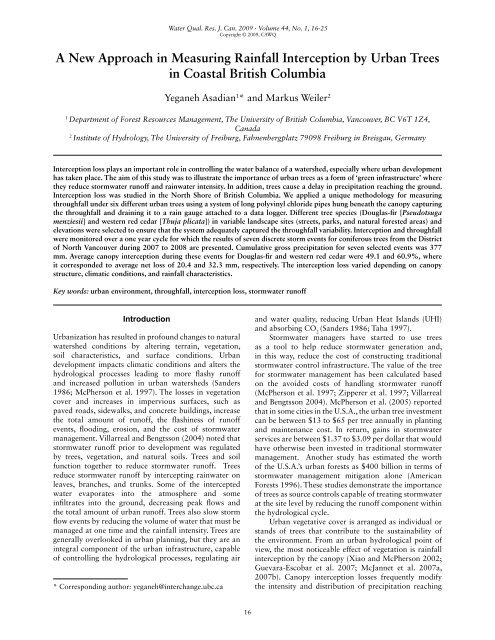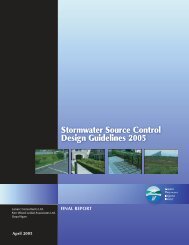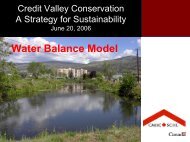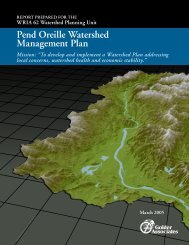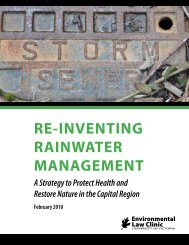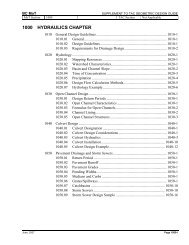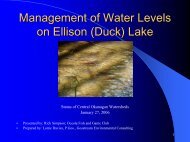A New Approach in Measuring Rainfall Interception by Urban Trees ...
A New Approach in Measuring Rainfall Interception by Urban Trees ...
A New Approach in Measuring Rainfall Interception by Urban Trees ...
You also want an ePaper? Increase the reach of your titles
YUMPU automatically turns print PDFs into web optimized ePapers that Google loves.
Water Qual. Res. J. Can. 2009 · Volume 44, No. 1, 16-25<br />
Copyright © 2009, CAWQ<br />
A <strong>New</strong> <strong>Approach</strong> <strong>in</strong> Measur<strong>in</strong>g Ra<strong>in</strong>fall <strong>Interception</strong> <strong>by</strong> <strong>Urban</strong> <strong>Trees</strong><br />
<strong>in</strong> Coastal British Columbia<br />
Yeganeh Asadian 1 * and Markus Weiler 2<br />
1<br />
Department of Forest Resources Management, The University of British Columbia, Vancouver, BC V6T 1Z4,<br />
Canada<br />
2<br />
Institute of Hydrology, The University of Freiburg, Fahnenbergplatz 79098 Freiburg <strong>in</strong> Breisgau, Germany<br />
<strong>Interception</strong> loss plays an important role <strong>in</strong> controll<strong>in</strong>g the water balance of a watershed, especially where urban development<br />
has taken place. The aim of this study was to illustrate the importance of urban trees as a form of ‘green <strong>in</strong>frastructure’ where<br />
they reduce stormwater runoff and ra<strong>in</strong>water <strong>in</strong>tensity. In addition, trees cause a delay <strong>in</strong> precipitation reach<strong>in</strong>g the ground.<br />
<strong>Interception</strong> loss was studied <strong>in</strong> the North Shore of British Columbia. We applied a unique methodology for measur<strong>in</strong>g<br />
throughfall under six different urban trees us<strong>in</strong>g a system of long polyv<strong>in</strong>yl chloride pipes hung beneath the canopy captur<strong>in</strong>g<br />
the throughfall and dra<strong>in</strong><strong>in</strong>g it to a ra<strong>in</strong> gauge attached to a data logger. Different tree species (Douglas-fir [Pseudotsuga<br />
menziesii] and western red cedar [Thuja plicata]) <strong>in</strong> variable landscape sites (streets, parks, and natural forested areas) and<br />
elevations were selected to ensure that the system adequately captured the throughfall variability. <strong>Interception</strong> and throughfall<br />
were monitored over a one year cycle for which the results of seven discrete storm events for coniferous trees from the District<br />
of North Vancouver dur<strong>in</strong>g 2007 to 2008 are presented. Cumulative gross precipitation for seven selected events was 377<br />
mm. Average canopy <strong>in</strong>terception dur<strong>in</strong>g these events for Douglas-fir and western red cedar were 49.1 and 60.9%, where<br />
it corresponded to average net loss of 20.4 and 32.3 mm, respectively. The <strong>in</strong>terception loss varied depend<strong>in</strong>g on canopy<br />
structure, climatic conditions, and ra<strong>in</strong>fall characteristics.<br />
Key words: urban environment, throughfall, <strong>in</strong>terception loss, stormwater runoff<br />
Introduction<br />
<strong>Urban</strong>ization has resulted <strong>in</strong> profound changes to natural<br />
watershed conditions <strong>by</strong> alter<strong>in</strong>g terra<strong>in</strong>, vegetation,<br />
soil characteristics, and surface conditions. <strong>Urban</strong><br />
development impacts climatic conditions and alters the<br />
hydrological processes lead<strong>in</strong>g to more flashy runoff<br />
and <strong>in</strong>creased pollution <strong>in</strong> urban watersheds (Sanders<br />
1986; McPherson et al. 1997). The losses <strong>in</strong> vegetation<br />
cover and <strong>in</strong>creases <strong>in</strong> impervious surfaces, such as<br />
paved roads, sidewalks, and concrete build<strong>in</strong>gs, <strong>in</strong>crease<br />
the total amount of runoff, the flash<strong>in</strong>ess of runoff<br />
events, flood<strong>in</strong>g, erosion, and the cost of stormwater<br />
management. Villarreal and Bengtsson (2004) noted that<br />
stormwater runoff prior to development was regulated<br />
<strong>by</strong> trees, vegetation, and natural soils. <strong>Trees</strong> and soil<br />
function together to reduce stormwater runoff. <strong>Trees</strong><br />
reduce stormwater runoff <strong>by</strong> <strong>in</strong>tercept<strong>in</strong>g ra<strong>in</strong>water on<br />
leaves, branches, and trunks. Some of the <strong>in</strong>tercepted<br />
water evaporates <strong>in</strong>to the atmosphere and some<br />
<strong>in</strong>filtrates <strong>in</strong>to the ground, decreas<strong>in</strong>g peak flows and<br />
the total amount of urban runoff. <strong>Trees</strong> also slow storm<br />
flow events <strong>by</strong> reduc<strong>in</strong>g the volume of water that must be<br />
managed at one time and the ra<strong>in</strong>fall <strong>in</strong>tensity. <strong>Trees</strong> are<br />
generally overlooked <strong>in</strong> urban plann<strong>in</strong>g, but they are an<br />
<strong>in</strong>tegral component of the urban <strong>in</strong>frastructure, capable<br />
of controll<strong>in</strong>g the hydrological processes, regulat<strong>in</strong>g air<br />
* Correspond<strong>in</strong>g author: yeganeh@<strong>in</strong>terchange.ubc.ca<br />
and water quality, reduc<strong>in</strong>g <strong>Urban</strong> Heat Islands (UHI)<br />
and absorb<strong>in</strong>g CO 2<br />
(Sanders 1986; Taha 1997).<br />
Stormwater managers have started to use trees<br />
as a tool to help reduce stormwater generation and,<br />
<strong>in</strong> this way, reduce the cost of construct<strong>in</strong>g traditional<br />
stormwater control <strong>in</strong>frastructure. The value of the tree<br />
for stormwater management has been calculated based<br />
on the avoided costs of handl<strong>in</strong>g stormwater runoff<br />
(McPherson et al. 1997; Zipperer et al. 1997; Villarreal<br />
and Bengtsson 2004). McPherson et al. (2005) reported<br />
that <strong>in</strong> some cities <strong>in</strong> the U.S.A., the urban tree <strong>in</strong>vestment<br />
can be between $13 to $65 per tree annually <strong>in</strong> plant<strong>in</strong>g<br />
and ma<strong>in</strong>tenance cost. In return, ga<strong>in</strong>s <strong>in</strong> stormwater<br />
services are between $1.37 to $3.09 per dollar that would<br />
have otherwise been <strong>in</strong>vested <strong>in</strong> traditional stormwater<br />
management. Another study has estimated the worth<br />
of the U.S.A.’s urban forests as $400 billion <strong>in</strong> terms of<br />
stormwater management mitigation alone (American<br />
Forests 1996). These studies demonstrate the importance<br />
of trees as source controls capable of treat<strong>in</strong>g stormwater<br />
at the site level <strong>by</strong> reduc<strong>in</strong>g the runoff component with<strong>in</strong><br />
the hydrological cycle.<br />
<strong>Urban</strong> vegetative cover is arranged as <strong>in</strong>dividual or<br />
stands of trees that contribute to the susta<strong>in</strong>ability of<br />
the environment. From an urban hydrological po<strong>in</strong>t of<br />
view, the most noticeable effect of vegetation is ra<strong>in</strong>fall<br />
<strong>in</strong>terception <strong>by</strong> the canopy (Xiao and McPherson 2002;<br />
Guevara-Escobar et al. 2007; McJannet et al. 2007a,<br />
2007b). Canopy <strong>in</strong>terception losses frequently modify<br />
the <strong>in</strong>tensity and distribution of precipitation reach<strong>in</strong>g<br />
16
Ra<strong>in</strong>fall <strong>Interception</strong><br />
the ground. <strong>Trees</strong> reta<strong>in</strong> water on site temporarily or<br />
permanently, slow<strong>in</strong>g the flow to waterways. Horton<br />
(1919) and Rutter et al. (1975) classified canopy<br />
<strong>in</strong>terception (I net<br />
) <strong>in</strong>to various components: a fraction<br />
of gross precipitation (P G<br />
) that falls as throughfall (p),<br />
the proportion that is diverted to stemflow (p t<br />
), and<br />
the proportion that is stored and evaporated. Canopy<br />
<strong>in</strong>terception represents the difference between gross<br />
precipitation (above canopy) and net precipitation<br />
(below canopy) (Jetten 1996; Aboal et al. 1999; Xiao et<br />
al. 2000a, 2000b).<br />
Previous studies on ra<strong>in</strong>fall <strong>in</strong>terception, primarily<br />
carried out <strong>in</strong> naturally forested areas, report a wide<br />
range of values for <strong>in</strong>terception losses, throughfall, and<br />
stemflow. <strong>Interception</strong> loss is commonly 20 to 40% <strong>in</strong><br />
coniferous, and between 10 to 20% <strong>in</strong> deciduous forests<br />
(Crockford and Richardson 1990; Llorens et al. 1997;<br />
L<strong>in</strong>k et al. 2004; Llorens and Dom<strong>in</strong>go 2007). The amount<br />
of <strong>in</strong>terception loss is highly dependent on forest structure<br />
(e.g., species, dimension, density), canopy structure (e.g.,<br />
foliation period, leaf and stem surface areas, gap fraction,<br />
surface detention storage capacity) and meteorological<br />
factors (e.g., ra<strong>in</strong>fall amount, duration, <strong>in</strong>tensity,<br />
frequency, temperature, w<strong>in</strong>d, humidity) (Crockford and<br />
Richardson 2000; Xiao and McPherson 2002; Nadkarni<br />
and Sumera 2004).<br />
While considerable research concern<strong>in</strong>g the impact<br />
of tree <strong>in</strong>terception loss on hydrological processes has<br />
been conducted <strong>in</strong> forested areas, the effects of urban<br />
trees on ra<strong>in</strong>fall <strong>in</strong>terception and runoff have not been<br />
well quantified. The characteristics of trees <strong>in</strong> forested<br />
areas are different from those <strong>in</strong> urban sett<strong>in</strong>gs <strong>in</strong> terms<br />
of available grow<strong>in</strong>g space, canopy cover, age, diversity,<br />
and microclimate (Zipperer et al. 1997; Xiao and<br />
McPherson 2002; Wang et al. 2008). The measurement<br />
and monitor<strong>in</strong>g methods <strong>in</strong>volved <strong>in</strong> closed forested<br />
areas ranged from troughs and ra<strong>in</strong> gauges to plastic<br />
sheets; however, it has been suggested that most of these<br />
common sampl<strong>in</strong>g techniques cause large errors <strong>in</strong> the<br />
estimated <strong>in</strong>terception (Horton 1919; Xiao et al. 2000b;<br />
L<strong>in</strong>k et al. 2004). It is important to note that sampl<strong>in</strong>g<br />
design that captures the throughfall variability is key <strong>in</strong><br />
determ<strong>in</strong><strong>in</strong>g the accuracy and time resolution of obta<strong>in</strong>ed<br />
data (Lundberg et al. 1997; Keim et al. 2005). These<br />
studies illustrate that ra<strong>in</strong>fall <strong>in</strong>terception <strong>by</strong> forests is<br />
extremely variable and difficult to measure.<br />
In urban sett<strong>in</strong>gs, field observations and experimental<br />
measurements of ra<strong>in</strong>fall <strong>in</strong>terception processes are sorely<br />
needed <strong>in</strong> order to better understand these processes.<br />
<strong>Urban</strong> tree <strong>in</strong>terception processes are somewhat different<br />
from those reported for natural forests as a result of<br />
various factors such as edge effect, isolation (greater<br />
distances between <strong>in</strong>dividuals), open canopies, higher<br />
temperatures, and w<strong>in</strong>d penetration and associated<br />
ra<strong>in</strong>fall (Zipperer et al. 1997; Guevara-Escobar et al.<br />
2007). These characteristics def<strong>in</strong>e the storage capacity<br />
for each stand or <strong>in</strong>dividual tree, and control the<br />
evapotranspiration rate.<br />
The objective of this paper was to ga<strong>in</strong> a better<br />
understand<strong>in</strong>g of the ra<strong>in</strong>fall <strong>in</strong>terception processes<br />
for a large number of urban trees, and to quantify the<br />
throughfall and estimate the <strong>in</strong>terception losses us<strong>in</strong>g an<br />
<strong>in</strong>novative monitor<strong>in</strong>g approach.<br />
Methods and Materials<br />
To address the objectives of this research with regard to<br />
ra<strong>in</strong>fall <strong>in</strong>terception, throughfall for six coniferous trees<br />
was measured along the North Shore (North Vancouver)<br />
<strong>in</strong> British Columbia dur<strong>in</strong>g 2007 to 2008. The selected<br />
trees were located on private and public properties along<br />
streets, parks, and <strong>in</strong> forested areas.<br />
Study Site and Climate<br />
North and West Vancouver are highly urbanized cities<br />
with <strong>in</strong>creas<strong>in</strong>g urban development that resulted <strong>in</strong> the<br />
creation of larger proportion of impervious surfaces. The<br />
dom<strong>in</strong>ant land use <strong>in</strong> these municipalities is residential,<br />
followed <strong>by</strong> <strong>in</strong>dustrial and commercial areas. The major<br />
rivers and creeks perta<strong>in</strong><strong>in</strong>g to these areas are: Capilano,<br />
MacKay, Mosquito, Lynn, and Seymour. The major<br />
concern regard<strong>in</strong>g these waterways is the direct dra<strong>in</strong>age<br />
of stormwater runoff <strong>in</strong>to the rivers lead<strong>in</strong>g to flood<strong>in</strong>g<br />
and nonpo<strong>in</strong>t sources of pollution (Environment Canada<br />
2007).<br />
The regional climate is characterized <strong>by</strong> cool, wet<br />
w<strong>in</strong>ters and warm, moderate summers. In Vancouver it<br />
is common to have more than 166 days per year with<br />
measurable precipitation on average. These coastal<br />
ra<strong>in</strong>fall events are described as long durations with low<br />
<strong>in</strong>tensities. The average annual precipitation near sea level<br />
ranges from 1,200 to 3,000 mm at higher elevations, with<br />
most of the ra<strong>in</strong>fall occurr<strong>in</strong>g <strong>in</strong> the w<strong>in</strong>ter. The amount<br />
of precipitation varies with elevation, <strong>in</strong>creas<strong>in</strong>g <strong>by</strong> about<br />
100 mm for every 100 m rise <strong>in</strong> altitude. Consequently,<br />
the North Shore receives more ra<strong>in</strong> and snowfall at<br />
higher elevations dur<strong>in</strong>g the w<strong>in</strong>ter. The average annual<br />
temperature is 10°C at sea level (Environment Canada<br />
2007).<br />
Experimental Design and Instrumentation<br />
Tree selection. The experimental setup focused on the<br />
direct measurement of throughfall for coniferous trees.<br />
The ma<strong>in</strong> coniferous species selected were Douglasfir<br />
(Pseudotsuga menziesii) and western red cedar<br />
(Thuja plicata). The trees were classified <strong>in</strong>to different<br />
types: dom<strong>in</strong>ant, codom<strong>in</strong>ant, s<strong>in</strong>gle, and forested area<br />
(control). Dom<strong>in</strong>ant species were the ma<strong>in</strong> overstory<br />
trees <strong>in</strong> a plant community, which contributed the most<br />
cover or basal area to the community. <strong>Trees</strong> with crowns<br />
receiv<strong>in</strong>g full light from above, but comparatively little<br />
from the sides, were def<strong>in</strong>ed as codom<strong>in</strong>ant species.<br />
S<strong>in</strong>gle stand<strong>in</strong>g trees were exposed to light and w<strong>in</strong>d<br />
from all sides. Forested areas were used as control sites,<br />
17
Asadian and Weiler<br />
where trees were embedded with<strong>in</strong> large groups of trees<br />
<strong>in</strong>dependent from any edge effect; these areas have little<br />
or no development (Oke et al. 1989; Zipperer et al. 1997;<br />
Brooks et al. 2003).<br />
Tree health condition was also assessed because it<br />
reflects the structural <strong>in</strong>tegrity. This assessment helped<br />
<strong>in</strong>dicate patterns of throughfall for <strong>in</strong>dividual trees. The<br />
rat<strong>in</strong>g of tree condition <strong>in</strong>volved analysis of the tree crown<br />
and the density of foliage. Two different classes were<br />
assessed based on density of the canopies for coniferous<br />
trees as good and poor. Tree health conditions <strong>in</strong> control<br />
sites were not evaluated as they were considered to be<br />
away from urban areas. These controls were assumed to<br />
be representative of health conditions <strong>in</strong> forested sett<strong>in</strong>gs,<br />
which are naturally variable.<br />
Throughfall measurement. The experimental unit built<br />
under each tree consisted of four components: a wooden<br />
frame, PVC (polyv<strong>in</strong>yl chloride) pipes, a ra<strong>in</strong> gauge, and<br />
a data logger. The wooden structure <strong>in</strong>cluded a platform<br />
on which the ra<strong>in</strong> gauge was placed. Four metal rods<br />
supported a wooden roof and held the platform together.<br />
This frame was mounted directly to the trunk of the tree.<br />
Two PVC pipes were used per experimental unit. They<br />
were hung at an angle from branches us<strong>in</strong>g ropes and<br />
bolts. The two pipes were positioned underneath the<br />
canopy of each tree based on the shape and structure of<br />
the tree <strong>in</strong> a way that the entire diameter of the canopy<br />
was covered. The length of each pipe was approximately<br />
3-m long, where three 0.85-m <strong>by</strong> 0.028-m slits were cut<br />
on top along the length of each pipe provid<strong>in</strong>g the total<br />
surface area of 0.1428 m 2 . The throughfall was captured<br />
<strong>by</strong> these open<strong>in</strong>gs and dra<strong>in</strong>ed <strong>in</strong>to a tipp<strong>in</strong>g bucket ra<strong>in</strong><br />
gauge (RAINEW, Ra<strong>in</strong>Wise Inc., Bar Harbor, Ma<strong>in</strong>e).<br />
Data loggers (HOBO, Onset Computer Corporation,<br />
Pocasset, Mass.) attached to the ra<strong>in</strong> gauges recorded both<br />
the air temperature and ra<strong>in</strong>fall events of the canopy. The<br />
temperatures recorded <strong>by</strong> the data loggers accounted for<br />
with<strong>in</strong>-canopy temperature variation, which is suggested<br />
to change along the vertical gradient and have a m<strong>in</strong>or<br />
impact on canopy <strong>in</strong>terception responses (Jetten 1996;<br />
Brooks et al. 2003). Overall, this flexible system allowed<br />
<strong>in</strong>dependent movement of the different components<br />
of each experimental unit without caus<strong>in</strong>g any serious<br />
damage to the entire structure (Fig. 1).<br />
Meteorological station. Gross precipitation was<br />
measured us<strong>in</strong>g control units of the same design (Fig. 2).<br />
These units were positioned on the rooftops of build<strong>in</strong>gs<br />
away from any structures that may block ra<strong>in</strong>fall. Figure<br />
3 illustrates the proximity of the six study sites <strong>in</strong> the<br />
District of North Vancouver to the ra<strong>in</strong> gauge on the<br />
rooftop. Additional climate stations were set up <strong>in</strong> each<br />
municipality to capture the meteorological variability<br />
along the elevation gradient. These climate stations were<br />
with<strong>in</strong> a 5-km radius of the study sites. Each station was<br />
equipped to measure barometric pressure, temperature,<br />
humidity, ra<strong>in</strong>fall, w<strong>in</strong>d speed, and direction. These<br />
Fig. 1. The ra<strong>in</strong>fall <strong>in</strong>terception measur<strong>in</strong>g system.<br />
Fig. 2. Reference experimental system <strong>in</strong>stalled on the rooftop<br />
of North Vancouver’s City Hall to measure gross precipitation<br />
(above canopy ra<strong>in</strong>fall).<br />
supplemental records were utilized to validate the tipp<strong>in</strong>g<br />
ra<strong>in</strong> gauge data, thus ensur<strong>in</strong>g correct identification of<br />
ra<strong>in</strong>fall events.<br />
Data collection and calibration. The data loggers were<br />
programmed to record the number of tipp<strong>in</strong>gs where<br />
these numbers were converted <strong>in</strong>to total amount of gross<br />
precipitation/throughfall and <strong>in</strong>tensity read<strong>in</strong>gs. The<br />
climate stations and ra<strong>in</strong> gauges were calibrated after the<br />
<strong>in</strong>stallation <strong>in</strong> the field.<br />
Methods for calculation. Table 1 shows the location<br />
and assessed attributes for the selected trees. Ra<strong>in</strong>fall<br />
events were def<strong>in</strong>ed as storms with cumulative gross<br />
precipitation exceed<strong>in</strong>g 1 mm, with a m<strong>in</strong>imum of four<br />
hours without precipitation between events. Numerous<br />
events were elim<strong>in</strong>ated due to clogg<strong>in</strong>g of ra<strong>in</strong> gauges <strong>by</strong><br />
leaves <strong>in</strong> late autumn and ice dur<strong>in</strong>g the w<strong>in</strong>ter season<br />
when temperature fell below 0ºC.<br />
In this study, stemflow was not measured s<strong>in</strong>ce<br />
it is considered to be a m<strong>in</strong>or component of the water<br />
balance for mature canopies especially conifers, where<br />
the branches slope downward from the stem. This<br />
structural characteristic m<strong>in</strong>imizes the probability for<br />
<strong>in</strong>tercepted water to be routed to the stem, even if a small<br />
amount of precipitation <strong>in</strong>tercepted <strong>in</strong> the upper canopy<br />
18
Ra<strong>in</strong>fall <strong>Interception</strong><br />
Fig. 3. Locations of study sites and the rooftop ra<strong>in</strong> gauge <strong>in</strong> the District of North Vancouver (orthophotos provided <strong>by</strong><br />
District of North Vancouver’s GIS Department).<br />
19
Asadian and Weiler<br />
still contributes to stemflow. In addition, the bark is<br />
ridged and ruffled where it absorbs greater amounts of<br />
water. The absorption of water <strong>by</strong> epiphytes and various<br />
moss species on branches and tree trunks also play a<br />
role <strong>in</strong> controll<strong>in</strong>g the stemflow. As a result we assumed<br />
the stemflow to be <strong>in</strong>significant, based on the results of<br />
previous research studies (Crockford and Richardson<br />
1990; Brooks et al. 2003; L<strong>in</strong>k et al. 2004; Llorens and<br />
Dom<strong>in</strong>go 2007).<br />
For this <strong>in</strong>vestigation we computed the total<br />
volume of throughfall captured underneath each tree for<br />
<strong>in</strong>dividual events <strong>by</strong> us<strong>in</strong>g the total number of tipp<strong>in</strong>gs<br />
and the obta<strong>in</strong>ed volume from calibration. To note, the<br />
difference between the surface areas of the PVC pipes<br />
and the ra<strong>in</strong> gauge (which is 4.2) was taken <strong>in</strong>to account.<br />
Canopy <strong>in</strong>terception was derived from the difference<br />
between the P G<br />
and p for <strong>in</strong>dividual events. The data for<br />
P G<br />
was obta<strong>in</strong>ed from the reference climate station on<br />
the rooftop of the District of North Vancouver; however,<br />
for comparison, Table 2 <strong>in</strong>cludes P G<br />
from a standard<br />
climate station <strong>in</strong> the District of North Vancouver, and<br />
a nonstandard ra<strong>in</strong> gauge on the rooftop of North<br />
Vancouver’s City Hall.<br />
Results<br />
The high spatial and temporal resolution of the throughfall<br />
data enabled us to determ<strong>in</strong>e canopy <strong>in</strong>terception losses<br />
for a wide range of trees (Xiao et al. 2000b; L<strong>in</strong>k et al.<br />
2004). The selected trees were differentiated <strong>by</strong> species,<br />
type, and health condition.<br />
Seven discrete storm events were chosen between<br />
October 2007 and June 2008. Table 3 highlights the<br />
event characteristics. Selected events generated 377 mm<br />
of gross precipitation with a maximum hourly ra<strong>in</strong>fall<br />
<strong>in</strong>tensity of 13.3 mm/hr. This <strong>in</strong>tensity corresponds to a<br />
two-year event <strong>in</strong> this area (Denault et al. 2006). These<br />
obta<strong>in</strong>ed results reflect on the ra<strong>in</strong>fall characteristics <strong>in</strong><br />
the North Shore, where the frontal system dur<strong>in</strong>g October<br />
through April produces long durations and relative low<br />
ra<strong>in</strong>fall <strong>in</strong>tensities.<br />
Climate and Precipitation Variability Dur<strong>in</strong>g an Event<br />
Precipitation and above- and with<strong>in</strong>-canopy climate<br />
data for Douglas-fir and western red cedar for event 3<br />
are shown <strong>in</strong> Fig. 4 and 5. These figures show the effect<br />
of the urban tree canopies on throughfall <strong>in</strong>tensity,<br />
and demonstrate the range of conditions controll<strong>in</strong>g<br />
<strong>in</strong>terception loss dur<strong>in</strong>g the ra<strong>in</strong>fall event.<br />
Event 3 began at 0500 hours on December 18<br />
and lasted 39 hours. Dur<strong>in</strong>g this period, 39.7 mm<br />
of precipitation was recorded <strong>by</strong> the reference ra<strong>in</strong><br />
gauge on the rooftop of North Vancouver’s District<br />
Hall. Precipitation <strong>in</strong>tensity, humidity, w<strong>in</strong>d speed, and<br />
temperature were typified as moderately low. Figures<br />
4a and 5a illustrate that there was not much variation<br />
between the measured temperatures above and below<br />
the canopy for both species. W<strong>in</strong>d speed was recorded<br />
below 0.1 m·s -1 , <strong>in</strong>dicat<strong>in</strong>g absence of w<strong>in</strong>d dur<strong>in</strong>g the<br />
event. Average humidity was above 95%. The amount of<br />
throughfall captured underneath each canopy averaged<br />
50.1 and 46.2% (19.9 mm and 18.3 mm) for Douglas-fir<br />
and western red cedar, respectively.<br />
Figures 4b and 5b show that throughfall levels for<br />
both species are not constant, but they are dynamic. The<br />
difference <strong>in</strong> gross precipitation and net precipitation<br />
magnitude is shown <strong>in</strong> Fig. 4c and 5c. Table 4 presents<br />
the delay <strong>in</strong> throughfall reach<strong>in</strong>g the ground for all study<br />
sites. The delay ranged from 6 to 7.5 hours for event 3.<br />
This delay did not affect the peak <strong>in</strong> net precipitation;<br />
however, as shown <strong>by</strong> Xiao and McPherson (2002), this<br />
delayed the peak runoff for a storm. Throughfall ceased<br />
roughly 3.8 hours after the ra<strong>in</strong>fall stopped.<br />
The average ra<strong>in</strong>fall <strong>in</strong>tensity for event 3 was<br />
determ<strong>in</strong>ed <strong>by</strong> divid<strong>in</strong>g the gross precipitation <strong>by</strong> the<br />
ra<strong>in</strong>fall duration. Figures 4c and 5c illustrate the impact<br />
of canopy on throughfall <strong>in</strong>tensity, and exemplify how<br />
the climatic conditions control evaporation dur<strong>in</strong>g the<br />
ra<strong>in</strong>fall event. Both temperature and w<strong>in</strong>d are suggested<br />
to play an important role <strong>in</strong> driv<strong>in</strong>g the evaporation rate,<br />
however, w<strong>in</strong>d was omitted due to low velocities, which<br />
were less than 0.1 m·s -1 (Brooks et al. 2003; L<strong>in</strong>k et al.<br />
2004).<br />
20
Ra<strong>in</strong>fall <strong>Interception</strong><br />
(a)<br />
(b)<br />
(c)<br />
Fig. 4. Meteorological and throughfall data for ra<strong>in</strong>fall event three (western red cedar).<br />
21
Asadian and Weiler<br />
Throughfall and <strong>in</strong>terception loss. <strong>Interception</strong> loss was<br />
def<strong>in</strong>ed as the difference between the total gross and<br />
total net precipitation. Table 5 summarizes throughfall<br />
and <strong>in</strong>terception losses for the selected trees and events.<br />
For events 1 and 2 there are no data available for one<br />
of the Douglas-fir trees (# 585) due to ra<strong>in</strong> gauge failure<br />
(clogg<strong>in</strong>g).<br />
When evaluat<strong>in</strong>g the average <strong>in</strong>terception losses, it<br />
is evident that two of the cedar trees (# 588 and 591)<br />
showed the highest <strong>in</strong>terception losses compared with<br />
the other selected trees dur<strong>in</strong>g the events <strong>in</strong> the fall and<br />
w<strong>in</strong>ter. Both western red cedar trees were codom<strong>in</strong>ant;<br />
however, one was of good health condition and the other,<br />
poor. Events 5, 6, and 7 occurred dur<strong>in</strong>g the spr<strong>in</strong>g and<br />
summer, where both Douglas-fir and western red cedar<br />
had high <strong>in</strong>terception losses. The highest <strong>in</strong>terception<br />
loss calculated was <strong>in</strong> event 6 <strong>by</strong> a dom<strong>in</strong>ant Douglas-fir<br />
of a poor condition. Based on the results, compared with<br />
western red cedar, the Douglas-fir trees showed a wider<br />
range of <strong>in</strong>terception losses dur<strong>in</strong>g the seasons.<br />
Event 5 was the smallest precipitation event with<br />
relatively moderate levels of <strong>in</strong>terception loss for all<br />
selected trees. Event 7 had the shortest duration <strong>in</strong><br />
comparison with the other selected events. The highest<br />
<strong>in</strong>terception loss was seen for event 6 with 26.3 mm<br />
of gross precipitation over 25 hours. The average<br />
temperature was recorded as 9.7ºC with a maximum<br />
ra<strong>in</strong>fall <strong>in</strong>tensity of 3.0 mm/hr. In general, ra<strong>in</strong>fall type<br />
plays a role <strong>in</strong> determ<strong>in</strong><strong>in</strong>g <strong>in</strong>terception loss. For <strong>in</strong>stance,<br />
a low <strong>in</strong>tensity, long-duration frontal ra<strong>in</strong>fall generates<br />
a different <strong>in</strong>terception loss than a high <strong>in</strong>tensity short<br />
duration convectional storm (Xiao et al. 2000a, 2000b;<br />
Pypker et al. 2005; Deguchi et al. 2006).<br />
Discussion<br />
The measurement of throughfall us<strong>in</strong>g gauges under<br />
<strong>in</strong>dividual tree canopies has been successfully conducted<br />
to estimate <strong>in</strong>terception loss. The methodology applied<br />
<strong>in</strong> this research is <strong>in</strong>novative and has not been applied<br />
<strong>in</strong> any other research with<strong>in</strong> urban environments. The<br />
measur<strong>in</strong>g system was easy to build and <strong>in</strong>stall, and<br />
the design m<strong>in</strong>imized evaporation and splash<strong>in</strong>g. These<br />
experimental units had the ability to collect spatially<br />
variable throughfall underneath the canopy.<br />
Net <strong>in</strong>terception loss is determ<strong>in</strong>ed as the difference<br />
between gross precipitation and the sum of throughfall<br />
and stemflow. In this study, we did not <strong>in</strong>clude the<br />
stemflow s<strong>in</strong>ce it was assumed to be negligible. Based on<br />
the obta<strong>in</strong>ed throughfall data, the average percent I net<br />
for<br />
(a)<br />
(b)<br />
(c)<br />
Fig. 5. Meteorological and throughfall data for ra<strong>in</strong>fall event three (Douglas-fir).<br />
22
Ra<strong>in</strong>fall <strong>Interception</strong><br />
the seven events ranged between 17 and 89%, which were<br />
4.8 and 22.0 mm of gross precipitation respectively. The<br />
lowest <strong>in</strong>terception losses occurred dur<strong>in</strong>g event 1 and 4.<br />
Based on the variability <strong>in</strong> ra<strong>in</strong>fall amount, <strong>in</strong>tensity, and<br />
duration the <strong>in</strong>terception losses for coniferous trees <strong>in</strong><br />
this study ranged from 5 to 98% (1.5 to 24.3 mm with<br />
reference to the amount of gross precipitation).<br />
Our results suggest that <strong>in</strong>terception losses for<br />
coniferous trees are significantly higher with<strong>in</strong> urban<br />
environments compared with forested areas. L<strong>in</strong>k et<br />
al. (2004) suggested that <strong>in</strong> temperate forests, annual<br />
<strong>in</strong>terception losses for coniferous canopies ranged from<br />
9 to 48%, while Bryant et al. (2005) reported 22.3%<br />
<strong>in</strong>terception loss <strong>in</strong> a p<strong>in</strong>e forest. The <strong>in</strong>terception values<br />
obta<strong>in</strong>ed <strong>in</strong> our study suggest that the <strong>in</strong>terception losses<br />
for trees <strong>in</strong> urban environments are twice as much as trees<br />
<strong>in</strong> natural forested areas. Possible factors contribut<strong>in</strong>g<br />
to these differences are UHIs (urban areas which have<br />
significantly higher temperatures than the surround<strong>in</strong>gs),<br />
greater distances between trees (edge effect), and open<br />
grown canopies.<br />
UHIs cause local-scale variation <strong>in</strong> temperature<br />
differences between urban and natural forested areas.<br />
Taha (1997) stated that the temperatures with<strong>in</strong> urban<br />
areas tend to be higher due to replacement of natural<br />
vegetation <strong>by</strong> man made structures, consequently<br />
result<strong>in</strong>g <strong>in</strong> less evapotranspiration. In addition, urban<br />
trees are isolated with greater distances between them,<br />
mak<strong>in</strong>g them more exposed dur<strong>in</strong>g severe weather<br />
events, unlike trees with<strong>in</strong> forested areas where they are<br />
surrounded <strong>by</strong> other trees (Aboal et al. 1999; Nadkarni<br />
and Sumera 2004). High w<strong>in</strong>d dur<strong>in</strong>g a ra<strong>in</strong>fall event can<br />
mechanically shake precipitation from the canopy and<br />
thus reduce <strong>in</strong>terception loss. W<strong>in</strong>ds dur<strong>in</strong>g evaporation<br />
can either shake precipitation loose, or <strong>in</strong>crease the rate<br />
of evaporation and decrease the time until maximum<br />
<strong>in</strong>terception capacity is atta<strong>in</strong>ed. <strong>Urban</strong> tree canopies are<br />
classified as open grown trees as a result of no <strong>in</strong>tertree<br />
competition; consequently, they have larger structural<br />
dimensions (e.g., larger storage capacity) than trees <strong>in</strong><br />
forests (Horton 1919; Zipperer et al. 1997; Brooks et al.<br />
2003). In our study, UHIs, isolation, and open canopies<br />
attributed higher <strong>in</strong>terception losses <strong>by</strong> urban trees.<br />
Tree health condition and type were also found to<br />
affect <strong>in</strong>terception rate. S<strong>in</strong>gle stand<strong>in</strong>g trees <strong>in</strong> good<br />
health were expected to have a higher <strong>in</strong>terception rate.<br />
This was demonstrated <strong>in</strong> some, but not <strong>in</strong> all the events. A<br />
codom<strong>in</strong>ant western red cedar of poor health <strong>in</strong>tercepted<br />
at higher rates compared with other trees of better health<br />
conditions and types. Also, a dom<strong>in</strong>ant Douglas-fir with<br />
poor canopy condition showed the highest <strong>in</strong>terception<br />
rate for event 6. Western red cedar trees generally had<br />
higher <strong>in</strong>terception losses compared with Douglas-firs.<br />
This is due to the differences <strong>in</strong> canopy structure between<br />
the two tree species. For the events between March and<br />
June, the <strong>in</strong>terception losses were relatively high for both<br />
species. The high rates can be expla<strong>in</strong>ed <strong>by</strong> small ra<strong>in</strong>fall<br />
events, where most of the water from the event is used to<br />
wet the crown surfaces.<br />
The time delay <strong>in</strong> throughfall penetrat<strong>in</strong>g through<br />
canopy was greatest for event 1 (8.5 to 45.5 h) <strong>in</strong><br />
comparison with events 2, 4, and 5 where there were<br />
no significant delays. Events 3, 6, and 7 had moderately<br />
higher time delays, however, lower than event 1. Tree<br />
type and health condition played an important role <strong>in</strong><br />
controll<strong>in</strong>g the time delay. For the seven events it was<br />
noticed that the dom<strong>in</strong>ant and codom<strong>in</strong>ant trees with<br />
good health conditions showed a longer time delay <strong>in</strong><br />
throughfall. Also, when compar<strong>in</strong>g the time delays<br />
between the two species, western red cedar showed later<br />
delays than Douglas-fir trees.<br />
<strong>Trees</strong> generally dampen ra<strong>in</strong>fall <strong>in</strong>tensity; however,<br />
there were <strong>in</strong>stances where the throughfall <strong>in</strong>tensity was<br />
equivalent or higher than the actual ra<strong>in</strong>fall <strong>in</strong>tensity.<br />
The highest throughfall <strong>in</strong>tensity was seen <strong>in</strong> event 3<br />
at 28.7 h. The throughfall <strong>in</strong>tensity exceeded the actual<br />
ra<strong>in</strong>fall <strong>in</strong>tensity <strong>by</strong> s<strong>in</strong>gle stand<strong>in</strong>g Douglas-fir and a<br />
codom<strong>in</strong>ant western red cedar. The calculated ra<strong>in</strong>fall<br />
<strong>in</strong>tensity was 6.0 mm/h while the througfall <strong>in</strong>tensities for<br />
Douglas-fir and western red cedar were recorded at 7.3<br />
and 8.0 mm/h. This variation can be expla<strong>in</strong>ed <strong>by</strong> ra<strong>in</strong>fall<br />
characteristics, meteorological factors, and structure<br />
of the canopy. It is evident <strong>in</strong> Fig. 4c and 5c that high<br />
throughfall <strong>in</strong>tensity is delayed <strong>in</strong> time for lower ra<strong>in</strong>fall<br />
<strong>in</strong>tensities. Crown density wetness is another factor to<br />
consider. As the crown dampens, the drip becomes larger,<br />
consequently result<strong>in</strong>g <strong>in</strong> higher throughfall <strong>in</strong>tensities.<br />
Another reason can be suggested to reflect on crown<br />
wetness. As the crown dampens the drip becomes larger,<br />
consequently result<strong>in</strong>g <strong>in</strong> higher throughfall <strong>in</strong>tensities<br />
(Crockford and Richardson 2000; Brooks et al. 2003).<br />
The observed reduction <strong>in</strong> throughfall <strong>in</strong>tensity <strong>by</strong><br />
tree canopies serves two purposes. First, it delays water<br />
reach<strong>in</strong>g the ground <strong>by</strong> temporary storage of the water<br />
on the tree. This storage both reduces and delays the peak<br />
<strong>in</strong> the stormwater runoff. Second, it protects the m<strong>in</strong>eral<br />
soil surface from the energy of ra<strong>in</strong>drops reach<strong>in</strong>g the<br />
ground at maximum velocity. Reduction of ra<strong>in</strong>drop<br />
energy <strong>by</strong> <strong>in</strong>terception m<strong>in</strong>imizes soil detachment and<br />
subsequent erosion, which <strong>in</strong> turn protects soil structure<br />
and <strong>in</strong>filtration capacity lead<strong>in</strong>g to less stormwater runoff<br />
(Xiao and McPherson 2002; Pypker et al. 2005). All<br />
the selected events demonstrated reduction <strong>in</strong> ra<strong>in</strong>drop<br />
energy <strong>by</strong> hav<strong>in</strong>g lower <strong>in</strong>tensities captured underneath<br />
the canopy. The differences <strong>in</strong> the magnitudes of ra<strong>in</strong>fall<br />
<strong>in</strong>tensity for the events were dependent on climatic<br />
conditions. A tree’s health condition, type, and species<br />
can be suggested to contribute to the differences <strong>in</strong><br />
throughfall <strong>in</strong>tensities.<br />
Our results confirm that canopy <strong>in</strong>terception loss is<br />
greater <strong>in</strong> urban areas due to isolation, open canopies,<br />
and higher temperatures. These higher <strong>in</strong>terception losses<br />
play an important role <strong>in</strong> controll<strong>in</strong>g stormwater runoff.<br />
This novel perspective of the <strong>in</strong>terception processes <strong>in</strong><br />
nonforested sett<strong>in</strong>gs may prove to be useful for modell<strong>in</strong>g<br />
future impacts of large-scale urban tree plant<strong>in</strong>gs on<br />
<strong>in</strong>terception and runoff.<br />
23
Asadian and Weiler<br />
Conclusion<br />
This study evaluated the <strong>in</strong>terception losses for<br />
coniferous species <strong>in</strong> North Vancouver. <strong>Interception</strong><br />
losses calculated for urban trees were approximately<br />
twice as great as those calculated for trees with<strong>in</strong> natural<br />
forest stands. The identified controls on <strong>in</strong>terception<br />
loss were meteorological factors, tree type, and health.<br />
The results were variable depend<strong>in</strong>g on location, tree<br />
health, and canopy structure. The <strong>in</strong>terspecies variation<br />
on <strong>in</strong>terception was evident as western red cedar trees<br />
showed higher <strong>in</strong>terception losses, longer time delays, and<br />
lower throughfall <strong>in</strong>tensities compared with Douglasfirs.<br />
The goal of this project was to shed some light on<br />
ra<strong>in</strong>fall <strong>in</strong>terception <strong>by</strong> s<strong>in</strong>gle and stands of trees <strong>in</strong><br />
urban environments <strong>in</strong> order to provide data, models,<br />
and additional <strong>in</strong>formation for planners, developers, and<br />
municipal eng<strong>in</strong>eers to utilize <strong>in</strong> the plann<strong>in</strong>g of future<br />
urban development. Us<strong>in</strong>g natural vegetation as a low<br />
impact development and best management practice is<br />
an effective technique as it controls stormwater runoff<br />
on site, mitigat<strong>in</strong>g the impacts of urbanization on urban<br />
hydrology at a local scale (Graham et al. 2004).<br />
Acknowledgments<br />
This research was supported <strong>in</strong> part <strong>by</strong> funds provided <strong>by</strong><br />
the District of North Vancouver, City of North Vancouver,<br />
District of West Vancouver, Greater Vancouver Regional<br />
District, Prov<strong>in</strong>ce of British Columbia, Realestate<br />
Foundation of British Columbia, Inter-Governmental<br />
Water Balance Model Partnership, and Canadian Water<br />
Network. We like to express our appreciation to the<br />
North Shore Mentally Handicapped Association for<br />
their assistance <strong>in</strong> assembl<strong>in</strong>g the structures for the<br />
experimental units. Special thanks for their valuable<br />
comments and discussions are given to Dan Moore and<br />
Hans Schreier. We also thank the reviewers for their<br />
constructive feedback.<br />
References<br />
Aboal JR, Jiménez MS, Morales D, Hernández JM. 1999.<br />
Ra<strong>in</strong>fall <strong>in</strong>terception <strong>in</strong> laurel forest <strong>in</strong> the Canary<br />
Islands. Agric. For. Meteorol. 97:73–86.<br />
American Forests. 1996. <strong>Urban</strong> ecological analysis<br />
report, Phase 1: Economic benefits and costs of the<br />
urban forest <strong>in</strong> low <strong>in</strong>come and non-low <strong>in</strong>come<br />
communities. F<strong>in</strong>al report NA-94-0297. American<br />
Forests. Wash<strong>in</strong>gton, D.C<br />
Brooks KN, Ffolliott PF, Gregersen HM, DeBano<br />
LF. 2003. Hydrology and the Management of<br />
Watersheds. Iowa State Press, Iowa.<br />
Bryant ML, Bhat S, Jacobs JM. 2005. Measurements and<br />
model<strong>in</strong>g of throughfall variability for five forest<br />
communities <strong>in</strong> the southeastern US. J. Hydrol.<br />
312:95–108.<br />
Crockford RH, Richardson DP. 1990. Partition<strong>in</strong>g of<br />
ra<strong>in</strong>fall <strong>in</strong> a eucalypt forest and p<strong>in</strong>e plantation<br />
<strong>in</strong> southeastern Australia: II stemflow and factors<br />
affect<strong>in</strong>g stemflow <strong>in</strong> a dry sclerophyll eucalypt forest<br />
and a p<strong>in</strong>us radiata plantation. Hydrol. Processes<br />
4:145–155.<br />
Crockford RH, Richardson DP. 2000. Partition<strong>in</strong>g of<br />
ra<strong>in</strong>fall <strong>in</strong>to throughfall, stemflow and <strong>in</strong>terception:<br />
effect of forest type, ground cover and climate.<br />
Hydrol. Processes 14:2903–2920.<br />
Deguchi A, Hattori S, Park H-T. 2006. The <strong>in</strong>fluence of<br />
seasonal changes <strong>in</strong> canopy structure on <strong>in</strong>terception<br />
loss: Application of the revised Gash model. J.<br />
Hydrol. 318:80–102.<br />
Denault C, Millar RG, Lence BJ. 2006. Assessment of<br />
possible impacts of climate change <strong>in</strong> an urban<br />
catchment. J. Am. Water. Resour. Assoc. 42:685–<br />
697.<br />
Environment Canada. 2007. National Climate Data and<br />
Information Archive (Climate Data Onl<strong>in</strong>e). Available<br />
on-l<strong>in</strong>e at: http://www.climate.weatheroffice.ec.gc.<br />
ca/climateData/canada_e.html [Accessed: April 27,<br />
2008].<br />
Graham P, Maclean L, Med<strong>in</strong>a D, Patwardhan A, Vasarhelyi<br />
G. 2004. The role of water balance modell<strong>in</strong>g <strong>in</strong> the<br />
transition to low impact development. Water Qual.<br />
Res. J. Can. 39:331–342.<br />
Guevara-Escobar A, González-Sosa E, Véliz-Chávez C,<br />
Ventura-Ramos E, Ramos-Sal<strong>in</strong>as M. 2007. Ra<strong>in</strong>fall<br />
<strong>in</strong>terception and distribution patterns of gross<br />
precipitation around an isolated Ficus benjam<strong>in</strong>a<br />
tree <strong>in</strong> an urban area. J. Hydrol. 333:532–541.<br />
Horton RE. 1919. Ra<strong>in</strong>fall <strong>in</strong>terception. Mon. Weather.<br />
Rev. 47:603–623.<br />
Jetten VG. 1996. <strong>Interception</strong> of tropical ra<strong>in</strong> forest:<br />
performance of a canopy water balance model.<br />
Hydrol. Processes 10:671–685.<br />
Keim RF, Skaugset AE, Weiler M. 2005. Temporal<br />
persistence of spatial patterns <strong>in</strong> throughfall. J.<br />
Hydrol. 314:263–274.<br />
L<strong>in</strong>k TE, Unsworth M, Marks D. 2004. The dynamics<br />
of ra<strong>in</strong>fall <strong>in</strong>terception <strong>by</strong> a seasonal temperate<br />
ra<strong>in</strong>forest. Agric. For. Meteorol. 124:171–191.<br />
Llorens P, Dom<strong>in</strong>go F. 2007. Ra<strong>in</strong>fall partition<strong>in</strong>g <strong>by</strong><br />
vegetation under Mediterranean conditions. A<br />
review of studies <strong>in</strong> Europe. J. Hydrol. 335:37–54.<br />
Llorens P, Poch R, Latron J, Gallart F. 1997. Ra<strong>in</strong>fall<br />
<strong>in</strong>terception <strong>by</strong> a P<strong>in</strong>us sylvestris forest patch<br />
overgrown <strong>in</strong> a Mediterranean mounta<strong>in</strong>ous<br />
abandoned area .1. Monitor<strong>in</strong>g design and results<br />
down to the event scale. J. Hydrol. 199:331–345.<br />
Lundberg A, Eriksson M, Halld<strong>in</strong> S, Kellner E, Seibert<br />
J. 1997. <strong>New</strong> approach to the measurement of<br />
<strong>in</strong>terception evaporation. Journal of Atmospheric<br />
and Oceanic Technology 14:1023–1035.<br />
McJannet D, Wallace J, Reddell P. 2007a. Precipitation<br />
<strong>in</strong>terception <strong>in</strong> Australian tropical ra<strong>in</strong>forests: I.<br />
Measurement of stemflow, throughfall and cloud<br />
<strong>in</strong>terception. Hydrol. Processes 21:1692-1702.<br />
24
Ra<strong>in</strong>fall <strong>Interception</strong><br />
McJannet D, Wallace J, Reddell P. 2007b. Precipitation<br />
<strong>in</strong>terception <strong>in</strong> Australian tropical ra<strong>in</strong>forests: II.<br />
Altitud<strong>in</strong>al gradients of cloud <strong>in</strong>terception, stemflow,<br />
throughfall and <strong>in</strong>terception. Hydrol. Processes<br />
21:1703–1718.<br />
McPherson EG, Nowak D, Heisler G, Grimmond S, Souch<br />
C, Grant R, Rowntree R. 1997. Quantify<strong>in</strong>g urban<br />
forest structure, function, and value: The Chicago<br />
<strong>Urban</strong> Forest Climate Project. <strong>Urban</strong> Ecosystems<br />
1:49–61.<br />
McPherson G, Simpson JR, Peper PJ, Maco SE, Xiao QF.<br />
2005. Municipal forest benefits and costs <strong>in</strong> five US<br />
cities. Journal of Forestry 103:411–416.<br />
Nadkarni NM, Sumera MM. 2004. Old-growth forest<br />
canopy structure and its relationship to throughfall<br />
<strong>in</strong>terception. Forest Science 50:290–298.<br />
Oke TR, Crowther JM, McNaughton KG, Monteith<br />
JL, Gard<strong>in</strong>er B. 1989. The micrometeorology of<br />
the urban forest [and discussion]. Philosophical<br />
Transactions of the Royal Society of London, Series<br />
B: Biol. Sci. 324:335–349.<br />
Pypker TG, Bond BJ, L<strong>in</strong>k TE, Marks D, Unsworth<br />
MH. 2005. The importance of canopy structure <strong>in</strong><br />
controll<strong>in</strong>g the <strong>in</strong>terception loss of ra<strong>in</strong>fall: Examples<br />
from a young and an old-growth Douglas-fir forest.<br />
Agric. For. Meteorol. 130:113–129.<br />
Rutter AJ, Morton AJ, Rob<strong>in</strong>s PC. 1975. A predictive<br />
model of ra<strong>in</strong>fall <strong>in</strong>terception <strong>in</strong> forests: II.<br />
Generalization of the model and comparison with<br />
observations <strong>in</strong> some coniferous and hardwood<br />
stands. J. Appl. Ecol. 12:367–380.<br />
Sanders RA. 1986. <strong>Urban</strong> vegetation impacts on the<br />
hydrology of Dayton, Ohio. <strong>Urban</strong> Ecology 9:361–<br />
376.<br />
Taha H. 1997. <strong>Urban</strong> climates and heat islands: Albedo,<br />
evapotranspiration, and anthropogenic heat. Energy<br />
and Build<strong>in</strong>gs 25:99–103.<br />
Villarreal EL, Bengtsson A. 2004. Inner city stormwater<br />
control us<strong>in</strong>g a comb<strong>in</strong>ation of best management<br />
practices. Ecol. Eng. 22:279–298.<br />
Wang J, Endreny TA, Nowak DJ. 2008. Mechanistic<br />
simulation of tree effects <strong>in</strong> an urban water balance<br />
model. J. Am. Water. Resour. Assoc. 44:75–85.<br />
Xiao Q, McPherson EG. 2002. Ra<strong>in</strong>fall <strong>in</strong>terception<br />
<strong>by</strong> Santa Monica’s municipal urban forest. <strong>Urban</strong><br />
Ecosystems 6:291–302.<br />
Xiao QF, McPherson EG, Ust<strong>in</strong> SL, Grismer ME. 2000. A<br />
new approach to model<strong>in</strong>g tree ra<strong>in</strong>fall <strong>in</strong>terception.<br />
J. Geophys. Res. [Atmos.] 105:29173–29188.<br />
Xiao QF, McPherson EG, Ust<strong>in</strong> SL, Grismer ME,<br />
Simpson JR. 2000. W<strong>in</strong>ter ra<strong>in</strong>fall <strong>in</strong>terception <strong>by</strong><br />
two mature open-grown trees <strong>in</strong> Davis, California.<br />
Hydrol. Processes 14:763–784.<br />
Zipperer WC, Sis<strong>in</strong>ni SM, Pouyat RV, Foresman TW.<br />
1997. <strong>Urban</strong> tree cover: An ecological perspective.<br />
<strong>Urban</strong> Ecosystems 1:229–246.<br />
Received: 30 June 2008; accepted: 17 December 2008.<br />
25


